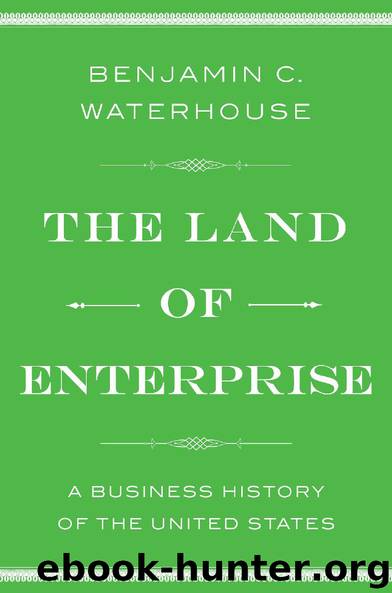The Land of Enterprise by Benjamin C. Waterhouse

Author:Benjamin C. Waterhouse
Language: eng
Format: epub
Publisher: Simon & Schuster
Business and the New Deal
After flying to Chicago to accept the Democratic Party’s nomination for president in the summer of 1932 (the first candidate to do so in person), New York governor Franklin D. Roosevelt promised that, if elected, he would offer “a new deal to the American people.” During the campaign, Roosevelt offered only vague strategies for fighting the Depression, and even once he took office the next March, his policies reflected an emergency mindset (which he called “bold, persistent experimentation”) rather than a coherent political philosophy. Nonetheless, the phrase “New Deal” stuck, and within a few years came to represent a new approach to government that forever recast the relationship between American business and the American state. 25
In his first two years in office, Roosevelt pushed through a wide-ranging series of reforms to stanch the economic bleeding, provide material relief to millions of suffering Americans, and shore up the nation’s ailing financial markets. Among the longest-lasting reforms to emerge from this period, which historians often call the “First New Deal” (1933–34), were key provisions of the Banking Act of 1933. This legislation created the Federal Deposit Insurance Corporation (FDIC), which prevented bank runs by providing a government backup to consumer bank deposits. In addition, four provisions of the law (often referred to as the “Glass-Steagall Act” after its Congressional sponsors) legally separated the functions of commercial and investment banks.
The most important part of Roosevelt’s first year in office, however, was more short-lived. In June 1933, Congress created the National Recovery Administration (NRA) to revive the national economy. I The NRA brought together representatives from the business community as well as organized labor to create “codes of fair competition,” setting standards for prices, distribution schedules, and wages in an effort to limit further business failures. Such top-down planning—instructing firms and industries how much to produce and telling workers how much they’d be paid—represented a radical approach to economic policy. By involving the leaders of large firms and labor groups, the NRA represented a model of “corporatism” that was far more common in European economies than in the United States. Yet big manufacturers largely supported the NRA, since it allowed them to remain profitable and reduced the threats of excessive competition. The president of the U.S. Chamber of Commerce wrote to Roosevelt: “The psychology of the country is now ready for self-regulation of industry with government approval of agreements reached either within or without trade conferences.” 26
If the NRA represented a power-sharing agreement between big business and the federal state, its dissolution by the Supreme Court marked a premature end to that compromise. In 1935, the Court ruled the NRA unconstitutional on two grounds. One, by giving the executive branch rule-making power, the law usurped the legislature’s constitutional authority. Two, by setting standards, such as minimum wages, that applied within states, the law overstepped the bounds of the Interstate Commerce Clause. 27
The destruction of the NRA, as well as calls from organized labor and other groups for even more aggressive business regulation, pushed President Roosevelt to the political left in 1935.
Download
This site does not store any files on its server. We only index and link to content provided by other sites. Please contact the content providers to delete copyright contents if any and email us, we'll remove relevant links or contents immediately.
International Integration of the Brazilian Economy by Elias C. Grivoyannis(90665)
The Radium Girls by Kate Moore(11921)
Turbulence by E. J. Noyes(7935)
Nudge - Improving Decisions about Health, Wealth, and Happiness by Thaler Sunstein(7613)
The Black Swan by Nassim Nicholas Taleb(7010)
Rich Dad Poor Dad by Robert T. Kiyosaki(6398)
Pioneering Portfolio Management by David F. Swensen(6226)
Man-made Catastrophes and Risk Information Concealment by Dmitry Chernov & Didier Sornette(5921)
Zero to One by Peter Thiel(5684)
Secrecy World by Jake Bernstein(4640)
Millionaire: The Philanderer, Gambler, and Duelist Who Invented Modern Finance by Janet Gleeson(4374)
The Age of Surveillance Capitalism by Shoshana Zuboff(4209)
Skin in the Game by Nassim Nicholas Taleb(4161)
Bullshit Jobs by David Graeber(4094)
The Money Culture by Michael Lewis(4073)
Skin in the Game: Hidden Asymmetries in Daily Life by Nassim Nicholas Taleb(3929)
The Dhandho Investor by Mohnish Pabrai(3698)
The Wisdom of Finance by Mihir Desai(3649)
Blockchain Basics by Daniel Drescher(3495)
